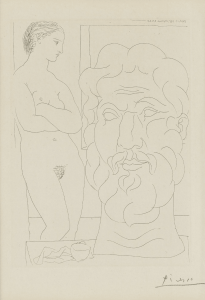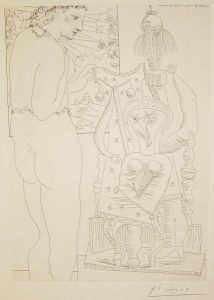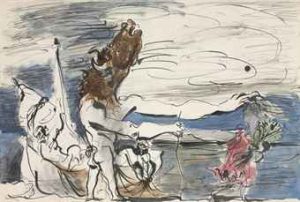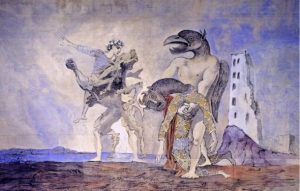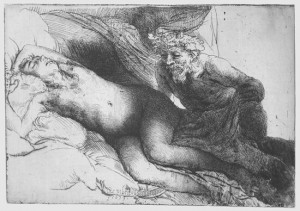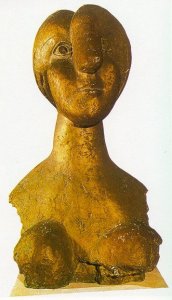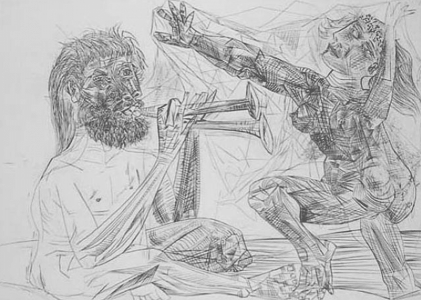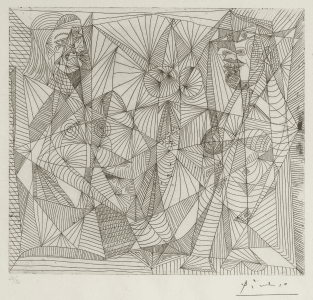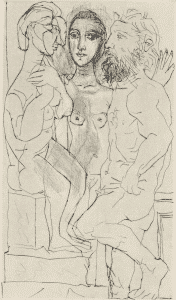
The Vollard Suite was named for its publisher, the famous Parisian art dealer and critic, Ambroise Vollard. Vollard gave Picasso his first show and served as his art dealer early on. In later years, he published two of Picasso’s illustrated books, and, emboldened by the success of those projects, commissioned Picasso in 1930 to create The Vollard Suite, a group of 100 prints which became Picasso’s most celebrated series. Picasso began creating these prints in 1933 and topped the series off in 1937 with three portraits of Vollard, who narcissistically insured that every one of his stable of artists created his portrait. Picasso turned the completed copper plates over to his master printer Roger Lacourière, who printed them in 1939. Vollard met an untimely death in a car accident that same year, and the print dealer Henri Petiet purchased the edition from Vollard’s estate. Petiet acquired the entirety of the edition with the exception of the three portraits of Vollard, which may not have been delivered to Vollard at the same time as the rest, and, more accidently than otherwise, were not included in Petiet’s purchase. (The only other prints that didn’t go to Petiet were the few trial proofs, which had been retained by Lacourière and not delivered to Vollard.) Petiet convinced Picasso to start signing the suite in the 1950s, which Picasso did sporadically for many years, probably up until 1969, when he was overwhelmed with the task of signing of The 347 Series.
Although The Vollard Suite is Picasso’s most famous print series, it is important for a collector to understand that Picasso created most of his prints as individual works of art rather than as parts of any series. Furthermore, acknowledging The Vollard Suite as his most famous series does not imply that the prints it comprises are his best prints. Some of his best prints are indeed found within the suite, but a number of other suite prints are, frankly, not all that accomplished. Other contemporaneously created prints are just as beautiful but, because they don’t bear the cachet of being a part of The Vollard Suite, sell for a fraction of the price, e.g. Femme Torero, IV (Bloch 280). And that, even though they are in general around five times rarer than The Vollard Suite prints! A discerning collector should pick and choose carefully, but at the very least should think twice before limiting his collection, or even just his collection of prints of the ‘thirties, to The Vollard Suite.
Though the Suite in general was an expression of his neoclassical style, Picasso interestingly integrated a number of other styles into some of the Suite, typically with exceptional results. One of the more wonderful examples of this blend is the drypoint pictured below, Sculpteur, Modèle et Sculpture Assise, (Bloch 146, Fig. 13). The sculptor and the model are gazing upon his creation as if to ask, exactly what kind of humanoid is she? This prints seems to occasion this sort of reflection about the Frankenstein because, unlike the other sculptures in the suite, this one seems almost as lifelike, and as life-size, as its admirers. In a way, the three figures seem engaged in a dialogue. The modestly folded arms of the creature almost seem to be saying, “What, who, me? Watcha starin’ at?” The other amusing pictorial element in this work is the model’s uncanny resemblance to Francoise Gilot, though this work precedes Picasso’s first encounter with that muse by a full decade. But it lends credence to what must be one of the best pick-up lines of all time, one which could only have been pulled off by a great portraitist such as Picasso, and which he tried on her shortly after their first meeting. He said something to the effect of (and I really need to find the exact reference), I’ve always had certain archetypes of women in my art and you’re one of them. I was painting you long before I met you. This line was on a par with his other classic one, by which he first invited Francoise to his apartment, ostensibly in order to see his etchings.
Table 8A. The Vollard Suite, 1930-37
| Bloch # | 136 | 139 | 143 | 146 | 148 | 149 | 150 | 152 | 154 | 155 |
| Beauty | * | * | ** | **** | ** | * | * | * | ** | * |
| Significance | ** | ** | ** | *** | ** | ** | ** | ** | ** | ** |
| Rarity | ||||||||||
| Size | ** | ** | *** | ** | ** | ** | ** | ** | ** | ** |
| Visibility at a distance | * | |||||||||
| Color | ||||||||||
| Fading | ||||||||||
| Cost* | * | ** | ** | *** | ** | ** | ** | ** | ** | ** |
| Desirability to cost ratio | * | |||||||||
| Signature | Y/N | Y/N | Y/N | Y/N | Y/N | Y/N | Y/N | Y/N | Y/N | Y/N |
(Note: Cost estimates in The Vollard Suite are for signed impressions.)
Table 8B. The Vollard Suite, 1930-37
| Bloch # | 156 | 157 | 160 | 161 | 162 | 164 | 165 | 166 | 167 | 168 |
| Beauty | ** | ** | * | * | *** | * | * | * | * | * |
| Significance | ** | ** | ** | ** | ** | ** | ** | ** | ** | ** |
| Rarity | ||||||||||
| Size | ** | ** | ** | ** | ** | ** | ** | ** | ** | ** |
| Visibility at a distance | ||||||||||
| Color | ||||||||||
| Fading | ||||||||||
| Cost* | * | ** | * | * | ** | ** | ** | ** | ** | ** |
| Desirability to cost ratio | * | * | * | * | ||||||
| Signature | Y/N | Y/N | Y/N | Y/N | Y/N | Y/N | Y/N | Y/N | Y/N | Y/N |
Table 8C. The Vollard Suite, 1930-37
| Bloch # | 169 | 170 | 171 | 172 | 173 | 174 | 175 | 176 | 177 | 178 |
| Beauty | ** | **** | *** | ** | * | ** | * | ** | ** | **** |
| Significance | ** | *** | ** | ** | ** | ** | ** | ** | ** | *** |
| Rarity | ||||||||||
| Size | ** | ** | ** | ** | ** | ** | *** | *** | *** | *** |
| Visibility at a distance | * | * | ||||||||
| Color | ||||||||||
| Fading | ||||||||||
| Cost* | * | ** | ** | ** | ** | ** | * | ** | *** | *** |
| Desirability to cost ratio | * | * | ||||||||
| Signature | Y/N | Y/N | Y/N | Y/N | Y/N | Y/N | Y/N | Y/N | Y | Y |
Sculptée (Bloch 170)
Surréaliste (Bloch 187)
Of the hundred prints of The Vollard Suite, in my mind the most humorous ones are Sculpteur, Modèle et Sculpture Assise (Bloch 146, Fig. 13), Modèle et Grande Tete Sculptée (Fig. 14, Bloch 170), Modèle et Sculpture Surréaliste (Bloch 187, Fig. 15), and Sculptures et Vase de Fleurs (Bloch 189, Fig. 15a). All of these are among the sculptor’s studio series, which, at forty-four prints or so, forms the plurality of the subject matter of The Vollard Suite. The last two of these more specifically belong in the subset of sixteen prints in which the sculptor has departed from the room, leaving his model and his creation to their own devices.
At first glance, perhaps there seems to be nothing unusual regarding the classical sculpture in the print, Modèle et Grande Tete Sculptée (Fig. 14, Bloch 170). Suddenly, however, you notice that you’re not the only one looking at the nude. Of all the Greco-Roman busts you’ve seen, haven’t they all been staring straight ahead with their fixed, featureless, stone-blind stare? Here, undeterred by the absence of iris and pupil to indicate the direction of the sculpture’s gaze, as is in keeping with the sightless classical sculptural canon, Picasso has nonetheless cleverly managed to turn the sculpture’s eyes to the side. The sculpted head doesn’t seem to mind, because now he can admire the nude’s attributes.
This second hilarious print (Fig. 15) depicts a sculpture of a woman whimsically assembled from household objects. Marie-Thérèse looks upon the sculpture, possibly not knowing what to make of it, a dry commentary on this culturally unsophisticated woman’s lack of understanding of her lover’s art. Although Picasso refused to call himself a surrealist, presumably to preserve his independence from that movement, his achievements in surrealist works of art are beyond comparison. One of the many reasons for the preeminence of his surrealist works is, in contradistinction to other artists’ typically somber, if not macabre, fare, Picasso used surrealism in part as just another vehicle for his boundless humor. Although he created many surrealist paintings and drawings, he made very few surrealist prints, and only three prints in this particular style, of which only this one was published in an edition.
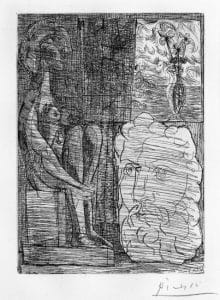
de Fleurs (Bloch 189)
Sculptures et Vase de Fleurs (Fig. 15a) is a recent addition to this page, because I just saw one in the flesh and it took my breath away. Lisa Florman has provided the following interesting analysis of this beautiful work,
This same sculpted male head appears in several other of the Vollard studio scenes from which the artist himself is absent…. [This image], if stylistically different, offers a variation on the same theme. There the living model has been replaced by a sculpted figure, but one that is still female, still nude, and still clearly the object of the male head’s scopic desire. The head, placed on the floor, eye-level to the center of his interest, would seem to be in a much better position than in plate 61 [Bloch 170, see above]. However, the sculpted nude, as if intentionally to block his voyeuristic gaze, clutches her knees tightly together. The dark hatching that enshrouds the left half of the room cuts her off even more from her would-be admirer. Similarly, the curtain drawn over the window falls exactly between the two figures, again emphasizing their separation and the occlusion of his vision. (Myth and Metamorphosis: Picasso’s Classical Prints of the 1930’s, page 118 and 122).
Table 8D. The Vollard Suite, 1930-37
| Bloch # | 180 | 181 | 182 | 183 | 184 | 185 | 186 | 187 | 188 | 189 | 190 |
| Beauty | *** | **** | **** | * | * | ** | * | **** | * | **** | * |
| Significance | ** | ** | *** | ** | ** | ** | ** | **** | ** | ** | ** |
| Rarity | |||||||||||
| Size | *** | ** | *** | ** | *** | *** | ** | ** | ** | ** | ** |
| Visibility at a distance | * | ** | ** | * | * | ** | |||||
| Color | |||||||||||
| Fading | |||||||||||
| Cost | * | * | ** | * | * | ** | ** | ** | ** | * | ** |
| Desirability to cost ratio | **** | **** | ** | ** | **** | ||||||
| Signature | Y/N | Y/N | Y/N | Y/N | Y/N | Y/N | Y/N | Y/N | Y/N | Y/N | Y/N |
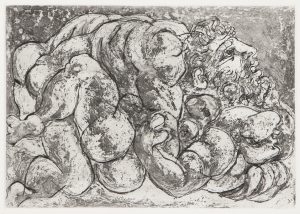
Of the five masterful Vollard Suite prints which have been variably termed as L’Étreinte (The Embrace) by Geiser and Baer, Le Viol (The Rape) by Bloch, and The Battle of Love by Bolliger, this striking etching and drypoint (Fig. 16, Bloch 181, 1933) is one of these amazing artworks. For a more complete discussion, see the webpage for this etching in our catalogue.
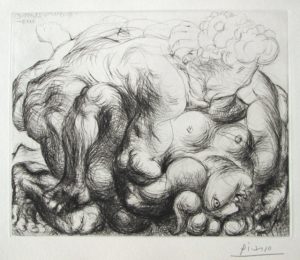
As a further strand in the interrelationships of the “Battle” and “Studio” prints, the male lover in L’Etreinte (Fig. 16b., B182) image casts his sightless eyes skyward, resembling the stony gaze of the neoclassical sculpted head in Modèle et Grande Tete Sculptée (Bloch 170), or even the three images of the blind minotaur elsewhere in the Suite.
Presumably because of the bad rap that the unfortunate term Le Viol has conferred on this set of prints, they are significantly undervalued. Quite a number of other lovemaking (or rape) scenes which Picasso created much later in his career do not suffer from this verbal judgment and from its resultant depression of their prices. Yet they do not come close to rivaling the beauty of these Vollard images (see Fig. 16a).
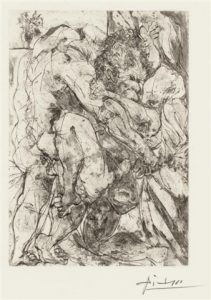
Fenêtre (Bloch 183)
Picasso completed most of the prints of The Vollard Suite in a single state. He labored over the copper of the present etching and drypoint, however, through fourteen states, more than any other in the suite. The second runner-up, at nine states, is Couple Faisant l’Amour (Bloch 202, next in our inventory catalogue at the time of this writing). Clearly, something about these rape or lovemaking scenes must have been very important to him.
Despite its grisly title, the action in this image is subject to the viewer’s interpretation. Just as in all the four other plates in the Suite that Bolliger named the “Battle of Love” series, the man may be violating the woman, or, as I prefer to think, the couple is engaged in passionate lovemaking. Picasso’s alleged misogyny has been sensationalized for years, starting with the initial, scathing reviews of Les Demoiselles d’Avignon. But, as I see it, Picasso loved women. Sure, the occasional femme fatale brought him down—a wife here, a lover there—but how uncommon is that? And, yes, he unflinchingly depicted the unvarnished truth of the human condition as he saw it. So though it is entirely possible that he would not have shrunk from portraying rape, I can’t quite imagine why he would have been motivated to do so, apart from riffs on historical works such as the rape of the Sabine women.
Picasso rarely titled or, for that matter, even discussed, his works of art. Though the job of naming them fell upon his long-time dealer, Kahnweiler, Picasso approved the titles. Georges Bloch used the “approved” titles in his thumbnail catalogue raisonné of the printed works. On the other hand, Brigitte Baer, his preeminent print chronicler, named his prints herself, using longer, more descriptive, and more flowery titles, but these are not titles that Picasso is known to have approved. Perhaps they amused him, if he even bothered with them. Yet Le Viol sous la Fenêtre (The Rape through the Window) is a title that appears in Bloch. But of course Vollard published The Vollard Suite, not Kahnweiler, and Bernhard Geiser, rather than Baer, initially edited the first two volumes of the Baer/Geiser catalogue. So who knows what the interchange may have been like between the artist and Vollard or Geiser regarding the naming of these works? Picasso was goofing on his interviewers, tongue-in-cheek, long before Bob Dylan—who later turned this sport into an equally high art—was born. So perhaps Picasso simply didn’t challenge Vollard or Geiser when one or the other came up with the various unfortunate titles in this group of prints.
One should note that in this case, as usual, Picasso deliberately failed to provide enough anecdotal detail to force the viewer into a particular understanding of his piece. His goal, according to Elizabeth Cowling, in stripping his work of its storyline was to enable his art to achieve a certain timelessness and universality. This is a pattern that he adopted beginning with the Blue Period, yet it got him into the most hot water with those Demoiselles. Speaking about that painting, Cowling states,
The lack of definition in the imagery left the moral tone of the picture in limbo. Had he, for example, made the women unequivocally prostitutes it might have seemed that he was presenting a moralistic vision of sexual turpitude. By not defining his subject, Picasso opened himself to the accusation of pure misogyny: all women, not just ‘sinful’ women, are implicated. And many writers have seen Les Demoiselles as an expression of revulsion at women and linked this with a permanent trait in Picasso’s nature. Rubin, for example, describes the ‘contrast between the horrid squatting demoiselle and the comparatively elegant Iberian maidens in the centre’ as an expression of ‘a very particular component of Picasso’s psychology: his deep-seated fear and loathing of the female body, which existed side by side with his craving for and ecstatic idealization of it.’
There may be truth in this. But it is important to recognize the deliberate violation of artistic convention which is at the heart of Picasso’s enterprise: women are given this scandalous treatment because, for better or worse, during the course of the nineteenth century woman had supplanted man as the primary vehicle for expressing abstract ideas and moral themes, just as the female model had supplanted the male model in the life room. Woman had, in short, become virtually synonymous with Art. The attack on artistic convention had therefore to be conducted through imagery of the female nude….
Picasso may have been giving vent, consciously or unconsciously, to private obsessions, but his revolutionary purpose was to claim the right to regenerate contemporary art through harshness, brutality, fearsomeness, disharmony. Beauty, especially the beauty of the eroticized female nude, had become too much of a ‘sham’—to use the word he used in 1935 when railing against the academic stereotype; it was time to give ugliness its due. (E. Cowling, Picasso: Style and Meaning, Phaidon 2002, p. 178-9)
The good news is that the market undervalues these prints because of their titles. Now I don’t know about you, but I see that as a buying opportunity.
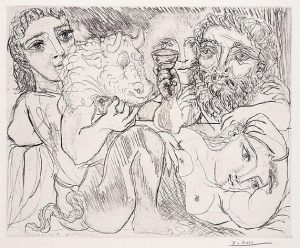
et Femmes (Bloch 200)
This large-format image from the Vollard series, Minotaure, Buveur, et Femmes (Fig. 17, Bloch 200), depicts an unusual twist on Picasso’s portrayals of the Minotaur in which this mythological chimera is represented as a mask held in the hand of a young actor. This young man also sports the Minotaur’s tail, which is suspended by a belt around his waist. Although Picasso’s meaning is impossible to plumb with certainty, it is at least interesting to note that the first state of this print unambiguously depicts a Minotaur in his entirety. By the second state, a metamorphosis has occurred which depicts an actor bearing the Minotaur’s mask. Is Picasso the artist saying that the sex drive of Picasso the man is only a mask and as such an interchangeable feature of his personality? Brigitte Baer is more impressed by the feminine qualities of the face of the young actor, and suggests that they indicate the feminine side of the Minotaur.
Elsewhere in the composition, Marie-Thérèse is represented in duplicate as both seated and reclining figures. A bearded man holds aloft a wine glass, a toast in celebration of life. Despite the presumed frivolity of the bacchanalian setting, a pensive, removed look is beautifully depicted in each of the faces. Is Picasso thereby also taking a step back from the immediacy of the celebration and considering the deeper meaning of his life?
Of the 100 works that comprise the Vollard Suite, there were but 17 prints of this size (including one larger). Of these large works, it is one of the most valuable and easily one of my favorites, especially because of the complex but tight composition, and the graphically masterful and tender depictions of the five visages therein. The thick black lines and the subtle gray tonality of this print as well as its comparatively large scale render it quite striking from across the room. I’ve had nearly transcendental experiences first viewing this print from afar, then at mid-range, and finally, from way up close, examining the drypoint’s textured, thick black line. To my eye, there is no more appealing line in the Vollard Suite than this.
Table 8E. The Vollard Suite, 1930-37
| Bloch # | 191 | 192 | 193 | 196 | 197 | 198 | 199 | 200 | 201 | 202 |
| Beauty | ** | ** | *** | *** | * | ** | *** | ***** | ***** | ** |
| Significance | ** | *** | *** | *** | ** | ** | ** | **** | **** | ** |
| Rarity | ||||||||||
| Size | *** | *** | ** | ** | ** | ** | ** | *** | *** | ** |
| Visibility at a distance | * | ** | ** | ** | ||||||
| Color | ||||||||||
| Fading | ||||||||||
| Cost* | ** | *** | ** | * | * | ** | ** | *** | **** | * |
| Desirability to cost ratio | * | ** | * | |||||||
| Signature | Y | Y | Y/N | Y/N | Y/N | Y/N | Y/N | Y/N | Y | Y/N |
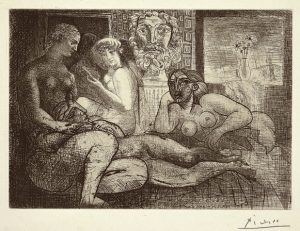
Tête Sculptée (Bloch 219)
Viewing the intricate work of art above is not a passive experience. Rather, this etching sweeps the viewer into itself. More than just a two-dimensional picture, it forcibly transports the viewer into an extraordinary space. The thick, dark, humid atmosphere is palpable, more akin to a harem than to a sculptor’s studio. The five figures are depicted with great care, finesse, and beauty as well as with an interesting juxtaposition of the artist’s neoclassical and sculptural-surrealist styles in the various renderings of the heads. This image is one of the four most prized of The Vollard Suite in the marketplace (the others are Bloch 201, 225, and 230).
Table 8F. The Vollard Suite, 1930-37
| Bloch # | 205 | 210 | 214 | 215 | 217 | 218 | 219 | 220 | 222 | 223 | 224 |
| Beauty | * | * | * | * | * | *** | ***** | ***** | **** | ** | * |
| Significance | ** | ** | ** | ** | ** | *** | ***** | **** | *** | *** | *** |
| Rarity | |||||||||||
| Size | ** | ** | ** | ** | ** | ** | ** | ** | *** | ** | ** |
| Visibility at a distance | * | *** | * | ** | ** | ** | |||||
| Color | |||||||||||
| Fading | |||||||||||
| Cost* | * | * | * | * | ** | ** | *** | ** | * | ** | ** |
| Desirability to cost ratio | * | * | * | **** | |||||||
| Signature | Y/N | Y/N | Y/N | Y/N | Y/N | Y/N | Y | Y/N | Y/N | Y/N | Y/N |
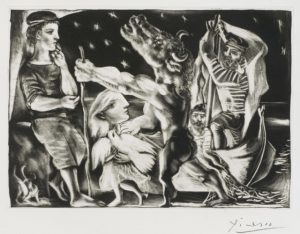
par une Fillette, IV (B225)
Picasso once said that art should not be afraid to tell a story. This print clearly tells a story, a rather complex one even by Picasso’s standards, but the question is: a story about what? Picasso certainly didn’t say. As usual, he provides the props and invites the viewer to write the script. This fantastical scene portrays a blinded Minotaur led through the night by a girl, whose features clearly represent his young mistress at that time, Marie-Thérèse. Although mythologically the Minotaur was a rapacious monster, Picasso, using poetic license, had toned him down the year before in a number of etchings and other works into a virile man-beast with an eye for feminine beauty, an allegorical stand-in for the artist himself. The final three etchings however depicted a wounded Minotaur. Picasso, still haunted by this imagery, returned to it a year later. Now the Minotaur is again shown in decline. Though still well-muscled, he is blind, leans on a cane, and requires the guidance of a young girl. His glazed eyes gaze heavenward, as if imploring the gods. The dove perhaps attests to the peace he has attained in his dotage, despite his infirmity and injuries.
Kirk Varnedoe, the former Chief Curator of Painting and Sculpture at the Museum of Modern Art, shed light on Picasso’s Minotaur series as follows: “At this point in his life, if not well before, he had come to think of himself as a “monster” in a complex way – not simply as a beast of marauding instincts but as a freak of nature in a higher sense. He gave friends to understand that he lacked complete comprehension of his own special creative powers; he said he felt commanded by, rather than only in possession of, his gifts. It is this imagining of himself simultaneously as a sacré monster [holy monster] and a monstre sacré [monstrous holy man], set apart by his special powers and isolated by inner forces fated to drive him according to their demands, which finds form in the part-man, part-animal who is both blessed and cursed by his transcendence of the conventions of human society.” (K. Varnedoe, “Picasso’s Self-Portraits”, pp. 110-79, W. Rubin, ed., Picasso and Portraiture: Representation and Transformation, London, 1996, pp. 153-55)
There is no precedent in Greek mythology for this sightless Minotaur, though mythologically the Minotaur did meet a violent death. One wonders whether Picasso, whose own sex drive has reached mythical proportions, at least in conventional wisdom, considered his unbridled sexuality a beast in need of taming, or a beast which fate would first maim—and then slay—over time. Picasso was famously afraid of death. Now at age 53, he may have been thinking about the future of his own sexual prowess. Perhaps Picasso was saying that the Minotaur—just as the artist—was driven by blind lust, and that lust may lead to unfortunate consequences. The blind Minotaur’s dependence on Marie-Thérèse is laden with other implications, notably Picasso’s reliance, despite his great intellect, upon this simple, earthy, uneducated, unsophisticated and very young girl (seventeen when they first met, to his approximately forty-six). Marie-Thérèse, despite her tender years, served the role of earth-mother, providing for him the intimate and uncomplicated connection with nature that was lacking in his marriage to Olga.
Interestingly, the sailor hoisting the sail is also rooted in the Greek myth: “To avenge the death of his son, Minos waged war and won. He then demanded that seven Athenian youths and seven maidens be sent every ninth year (some accounts say every year) to be devoured by the Minotaur. When the third sacrifice came round, Theseus volunteered to go to slay the monster. He promised to his father, Aegeus, that he would put up a white sail on his journey back home if he was successful.” (Wikipedia)
Picasso created five preparatory drawings and three etchings before this print. The Blind Minotaur Guided by a Young Girl, III (Fig. 19) is their epitome, as well as the pinnacle of The Vollard Suite. It is also one of Picasso’s most famous prints and widely regarded as one of his ten best. (Please see the related discussion at “Picasso’s Greatest Print?”)
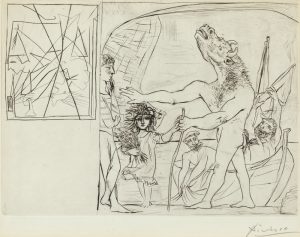
par une Fillette, I (B222)
This early take on the Blind Minotaur led by a girl has grown on me lately. When I first glanced at it, I dismissed it because of the curious, X-ed out sketch in the corner, which I thought detracted from the appeal of the main composition. Perhaps you did, too. But over time, as I studied the work more intently, my opinions evolved. First I came to realize that the portraits in the central image are quite wonderful, especially that of the Minotaur, not as fully realized as the final work in the Blind Minotaur series, Bloch 225, but easily as strong as the two intermediate works, B223 and 224. And unlike those two, this etching is one of the larger Vollard Suite prints, so the central composition turns out almost as large as they are. (It is noteworthy that the curators of the two landmark Picasso print exhibits referenced above chose to include only this first print from the series in the case of Fryberger, and the first and final ones, B222 and 225, in the case of Baer. Baer’s choice is doubly significant since she was Picasso’s primary print chronicler, having written the last six volumes of the eight-volume catalogue raisonné of Picasso prints.) Then, one day, I took the time to look closely at the corner sketch and realized that it must be an upside-down depiction of the assasination of Jean Paul Marat. A brief investigation confirmed my suspicions, revealing that the corner etching is indeed entitled La Mort de Marat (Bloch 282). Picasso created it just two months earlier, and it was published right side up in a very limited edition (24 proofs, some hand-colored) as the frontispiece of an artist’s book (De derriére les fagots, by the surrealist poet Benjamin Péret):
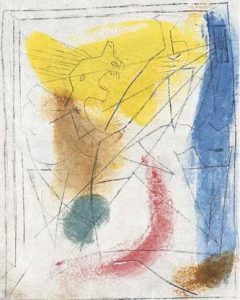
Picasso did some funny things. In fact, he made a career of them. But he was a very wealthy man long before he flipped this copper around and reused it–he certainly could have afforded a clean slate. Yet thirty years later he was painting on cardboard, so go know.Three years earlier, Picasso had first turned to the subject of Marat in an oil on canvas now at the Picasso Museum Paris:

Marat was a French revolutionary writer who sat out the revolution in a bath tub because of a debilitating skin affliction. His assassination in 1793 by Charlotte Corday was first portrayed that same year in a celebrated painting by Jacques-Louis David, depicting Marat after Corday had stabbed him to death in his bathtub:
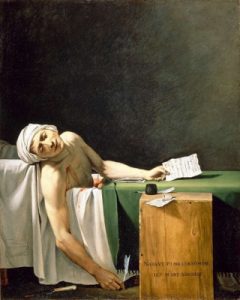
For those of you unfamiliar with the story, an excellent, concise biography of Marat which also provides an interesting and brief history of the French Revolution is the recent book, Jean Paul Marat, by Clifford D. Conner (Pluto Press, 2012). For a quirky fictionalized version of the life and death of Marat, rent the brilliant Marat/Sade, filmed from the British production of the play by Peter Weiss, directed by Peter Brook with Glenda Jackson as Charlotte Corday–one of my favorite plays of all time. It is actually a play within a play, in which the Marquis de Sade observes the reenactment of Marat’s life and death by the inmates of a lunatic asylum. (As you might imagine, it is inadvisable for young audiences.)
Picasso also took liberties with history. By 1934, when he returned to this theme, both assassin and victim have become women. If that is not clearly evident in the above etching, it is unmistakable in two drawings which preceded it: Mort de Marat (07-07-34, pencil PP34-087) and Le Meurtre(The Murder, 07-10-34, India ink PP34-089), both now in the Museum Picasso Paris. Picasso may have been thinking of the potential of his first wife Olga to become violent upon learning of his still secret affair with Marie-Thérèse.
Picasso then turned from the story of Marat to develop the theme of the Blind Minotaur. Presumably the tragic similarities between the stricken revolutionary and the maimed monster inspired him to include both of them in the same etching. The parallel between the man who shaped the French Revolution and the man who charted the course of modern art certainly could not have escaped Picasso. As he now again took up this copper, Picasso first etched a vertical line next to theDeath of Marat, dividing it into two parts. He then drew a simple arch, in two bold strokes placing the viewer in the Mediterranean villa from which she observes the unfolding drama. The Marat hangs next to the arch with a border resembling a frame, as if the absent-minded homeowner had carelessly hung a painting upside-down.
Picasso later began extensive work on the principal composition, torturing the copper plate through twelve states. In the final state, he cancelled theDeath of Marat, as if to say that Marat’s fate, though inevitably awaiting the Minotaur–and all of us–has been forestalled for another day.
The etching at hand was his first foray on the subject of the blind Minotaur, accompanied by a drawing that same day. This drawing and one other are in the collection of the Museum Picasso Paris. Maya Widmaier Picasso and Marina Picasso each own another, and Marina also has a pencil drawing of the blind Minotaur alone. The only one that has ever appeared in the market was a 51 cm work on paper from that year (PP34-125; without more precise dating) that sold at Christie’s London on 02-06-13 for close to 4.5 million USD:
The Christie’s catalogue included an excellent essay on the subject, reproduced below almost in its entirety:
‘[Picasso] identifies above all with the Minotaur, this mythological creature who was half bull and half man, to whom maidens had to be sacrificed. However, Picasso’s Minotaur is not always a monster; on the contrary, he is a poignant creature, a victim like himself of misfortune and tragedy–blinded by fate and love for the little girl–Marie-Thérèse, of course–who leads him around’ (John Richardson, quoted in M. Pressman, ‘Q & A: John Richardson on Picasso’s “Uncontrollable” Sex Drive’, Vanity Fair, 5 April 2011, reproduced online).
Minotaure aveugle conduit par une petite fillette dates from 1934, the pinnacle of Pablo Picasso’s involvement with and exploration of the theme of the Minotaur. This lyrical work is a showcase for Picasso’s draughtsmanship. This is particularly in evidence in the exquisite rendering of the head of the Minotaur, a figure in the Spanish artist’s lexicon that was inextricably linked to his own personality and identity, and also in the girl leading him, holding a bunch of flowers, a beacon of youth, purity and beauty…. The profile of the girl unmistakably echoes the features of Picasso’s young lover, Marie-Thérèse Walter, who since the late 1920s had been his Muse, ushering a new sensuality into his works and resulting in many of the flowing, fluid depictions of female figures that remain among his most celebrated works. This was especially true of the pictures associated with Picasso’s haven near Paris, the château of Boisgeloup which he had acquired in part to cater to the tastes and social interests of his first wife, Olga, but which would become associated with Marie-Thérèse in many of the works from the first half of the 1930s.
The character of the Minotaur had gleefully leapt into Picasso’s works in the late 1920s, most notably in the cartoon he prepared for a tapestry to be created for his friend and patron Maria Cuttoli where a bull’s head sat astride a torso-less pair of running legs; the cartoon is now in the Musée national d’Art moderne, Paris. Gradually, not least in his Vollard Suite set in a mythical world of classicism and chimeras, the Minotaur became an increasingly important central figure for Picasso, echoing both ancient myth in Greece and current culture in his native Spain, where the bullfight was such a source of fascination for him. His interest in bullfighting had been further piqued by his recent trips to Spain, which he visited in 1933 and 1934, following the declaration of the Republic there. Picasso would thence explore the motif of the bull and crucially of the Minotaur increasingly in prints, drawings and a handful of paintings, many of which remain in the Musée Picasso, Paris. This includes a pencil drawing that is clearly related to Minotaure aveugle conduit par une petite fillette and which was signed in Boisgeloup on 22 September 1934; Picasso also created a print of the same subject that day, again showing the girl, holding flowers, leading the stricken monster while fishermen watched on from their boat in the background [the present etching, Bloch 222].
In many of Picasso’s earlier images of the Minotaur, he was shown priapic, often carousing, indulging in orgies. This was also the case of hisSilenus of 1933, which showed the old man of myth, doubtless another self-conscious and unflattering substitute for Picasso, cavorting along a beach similar to the one in Minotaure aveugle conduit par une petite fillette, on that occasion in the company of voluptuous women, probably invoking his younger lover. These images both echo Picasso’s own associations with the outdoors-loving Marie-Thérèse and the seaside. Soon, however, a more solemn and tragic note was struck in these mythological scenes, especially in the form described by John Richardson, the artist’s great biographer, as ‘the blinded Minotaur – a surrogate for Picasso in some of his finest engravings’ (J. Richardson, A Life of Picasso: The Triumphant Years 1917-1932, London, 2007, p. 489). During the mid-1930s, when Picasso’s marriage to Olga was causing great problems in part because of his relationship with Marie-Thérèse Walter, he presented the Minotaur increasingly as a hunted and tortured freak of nature, a victim of persecution and pursuit, wounded, gored or blinded by the world around it.
This was in part a response to his own personal situation, as he tried to extricate himself from his marriage to Olga yet found this harder and harder. In Minotaure aveugle conduit par une petite fillette…he would be shown as the creature of legend, blinded but fortunately guided by the peaceful girl; meanwhile, in his parallel images of bullfights, or Tauromachies, he clearly identified with the un-transmuted bull, often shown gored by the picadors, relentlessly brought down and humiliated in a series of ritualized blows. This is clearly the case in the pitiful cry of the bull in his 1934 painting now in the Metropolitan Museum of Art, New York, in which the creature’s head bears a resemblance to that in Minotaure aveugle conduit par une petite fillette. The cry of the Minotaur and the cry of the bull in these pictures from the mid-1930s would later come to be channelled in the animal howl of the horse at the centre of Picasso’s Guernica – Minotaure aveugle conduit par une petite fillette clearly shows the evolution of his work as it progressed in that direction. This cross-germination also reveals the contrasts between light and darkness, hope and torment of the period, be it in Picasso’s own life, in the increasing tensions in Spain and in the wider state of the world at the time, as Germany turned towards Fascism and Europe stumbled towards War.
In Minotaure aveugle conduit par une petite fillette, the more personal, tragic side of the Minotaur has been brought to the fore as the wounded protagonist is passively being led by a small girl holding flowers, in vivid contrast to the implied violence of his maiming. This girl would reappear in the Minotauromachie of the following year holding aloft a lamp that pierces the darkness that dominates the composition. In Minotaure aveugle conduit par une petite fillette, the girl, whose features recall Picasso’s depictions of Marie-Thérèse, is looking back at the Minotaur, whose head is raised in a plaintive cry, while he progresses, blind, relying on her guidance and a stick. In the background is a boat, its mast in the air, vividly recalling the world of the ancient Mediterranean in which the myth of the Minotaur was set. The image clearly struck a chord with Picasso, who explored it in a range of media and variations, usually in the prints he was creating at the time, including those of the celebrated Vollard Suite.
The Minotaur, a potent and untamed mixture of human and bestial nature, was a key concept and symbol both for Picasso and for the Surrealists, hence the popularity of his collaged cover for the first edition of the periodical Minotaure, published by Tériade. For that publication, Picasso created a collage now in the Museum of Modern Art, New York, which featured as its centerpiece one of his own prints of the Minotaur stalking with a dagger in hand. Despite the popularity of the Minotaur as a subject with André Breton and his fellow Surrealists, Picasso’s friend Brassaï pointed out that there was a difference in interpretation and relevance between their Minotaur and the Spanish artist’s: while the former felt that the Minotaur encapsulated the Irrational,
‘For the painter of Guernica, this ancient symbol, half-man, half-bull, was not far removed from the toro of Spanish bullfights, laden with obscure, volatile forces. Picasso felt these dark forces moving within himself, and he humanized them. His Minotaur personified the “monster” – sardonic, dangerous of course, but also alive, its nostrils belching smoke and dilated by a desire that drove it to lust after nude, sleeping girls’ (Brassaï, Conversations with Picasso, J.M. Todd, trans., Chicago & London, 2002, pp. 8-9).
While Picasso himself discussed his earlier pictures of the Minotaur as being ‘dandies and dilettantes’ embroiled in a world of endless orgies and festivities, he himself was aware of the tragic aspect of this creature within his own personal mythology. ‘A minotaur can’t be loved for himself,’ he told Françoise Gilot. ‘At least he doesn’t think he can. It just doesn’t seem reasonable to him, somehow’ (Picasso, quoted in F. Gilot & C. Lake, Life with Picasso, New York, Toronto & London, 1964, p. 50). Picasso saw himself as this monster, as a hirsute force of nature, all the more so now that he, while in his fifties, was having an affair with a woman three decades his junior, an awareness of which was painfully evoked by his image of Silenus. While the earlier scenes of Minotaurs saw them in their sensual revels, now a more mature aspect of the relationship came to the fore, a tender dependence, the monster humbled yet still supported. As Kirk Varnedoe has explained about similar images:
‘At this point in his life, if not well before, he had come to think of himself as a “monster” in a complex way – not simply as a beast of marauding instincts but as a freak of nature in a higher sense. He gave friends to understand that he lacked complete comprehension of his own special creative powers; he said he felt commanded by, rather than only in possession of, his gifts. It is this imagining of himself simultaneously as a sacré monsterand a monstre sacré, set apart by his special powers and isolated by inner forces fated to drive him according to their demands, which finds form in the part-man, part-animal who is both blessed and cursed by his transcendence of the conventions of human society.’ (K. Varnedoe, ‘Picasso’s Self-Portraits’, pp. 110-79, W. Rubin, ed., Picasso and Portraiture: Representation and Transformation, London, 1996, pp. 153-55).
Picasso’s imagination eventually led him to the Minotaur’s end, which he portrayed in a huge painting, over 9 x 12 meters, which he created as a backdrop for the play Le 14 juillet (The 14th July) in 1936. As if any doubt remained of the artist’s identification with this creature, he dressed the poor beast in the costume of Harlequin, another one of his well-known stand-ins:
To pick up an earlier thread, perhaps Picasso uttered his statement about art and story-telling at a time when modern art was given to abstraction, especially in America, and Picasso’s fame was consequently temporarily declining. Frankly, I’ve never really thought that narrative art was contentious, until recently a client got me thinking about it. In trying to refine my understanding of his preferences (the better to ply him with Picasso choices he couldn’t refuse), I learned that he deplores “narrative pictures”. He listed the artist and his model as an example of narrative pictures that he disliked. Yet he happens to live happily with an impression of this very print! On the opposite extreme, another client fell in love with a linocut and concocted a whole cock-and-bull story to go with it (Trois Femmes, Bloch 926: life passages, i.e. the innocence of the young woman on the right, her middle-aged ennui in the middle, and the contemplative wisdom of her old age on the left—frankly I started liking this print more in light of her exegesis, but not enough that I didn’t try to steer her in favor of more beautiful Picassos). Which goes to show that, ultimately, I only understand the mind of one collector—mine—and even then only fleetingly.
Table 8G. The Vollard Suite, 1930-37
| Bloch # | 225 | 226 | 228 | 229 | 230 | 231 | 232 | 233 |
| Beauty | ***** | * | ** | ***** | * | |||
| Significance | ***** | *** | ** | *** | **** | * | * | * |
| Rarity | ||||||||
| Size | *** | ** | ** | *** | **** | *** | *** | *** |
| Visibility at a distance | **** | **** | * | * | ||||
| Color | ||||||||
| Fading | ||||||||
| Cost* | **** | *** | ** | *** | **** | * | * | * |
| Desirability to cost ratio | * | * | ||||||
| Signature | Y | Y/N | Y/N | Y/N | Y | Y | Y | Y |
(Note: Cost estimates in The Vollard Suite are for signed impressions.)
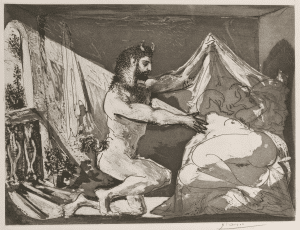
Faune devoilant une femme (Fig. 19b) is the largest and one of the two most celebrated of the 100 prints that comprise La Suite Vollard. Although in terms of valuation, the market usually places The Blind Minotaur (B225) just ahead of it, two of the above references, including Brigitte Baer, the principle chronicler of Picasso’s prints, considered it the Suite‘s pinnacle. Baer best described The Faun Unveiling a Woman, as follows:
Picasso would continue to love, paint and draw Marie-Thérèse for many years to come, and some of these portraits are among the finest of his career. He evoked their ‘family’ clandestinely reunited at Juan-les-Pins ln the marvelous drawings of April 1936, and he depicted the sad eyes of Marie-Therese as she showed to him, in a mirror, his own image of a dying faun (which no doubt she regreted as he regreted the Minotaur he was) in the Death of a Monster series. But his passion for her was that of the Minotaur and a Minotaur cannot share anything with a child; he is too afraid to destroy. Without passion, there is no more Muse. Marie-Thérèse disappeared from the engraved work in 1936 with the Jeune fille regardent fuir une hirondelle dans un miroir (B290) and above all, so magnificently, with the Faune devoilant une femme of the 12th of June, a work that looks back nostalgically on their stay in Juan-les-Pins and on a passion that had changed. This aquatint, the most successful print in the Suite Vollard and one of the most beautiful in the artist’s engraved work, has a special quality: the more one studies it–the six states pose many technical and other problems–the more lyrical and mysterious it becomes, claiming clear title to the label of ‘masterpiece’.
Although unhappily we cannot exhibit the six states of the print here, they tell a kind of fairy tale. The sleeping (dreaming?) woman hardly changes at all. Step by step, however, the light streaming in from the balcony and washing over the room becomes more and more lunar, until it takes on that pale mysterious tonality of the full moon. (Picasso continually reworked the aquatint in every conceivable way in order to perfect the lighting via a process which certainly must have bored such an impatient man as he). There is another interesting detail: in the 1st state, on the balcony, stands a flower-pot with a strawberry plant in it. Picasso, who had not the vaguest idea about flowers or plants or the countryside in general changed this in the 3rd state into a pot filled with basil. According to Mediterranean folklore, basil has the power to change, particularly at the time of a full moon, any ordinary animal into a wonderful creature, a sort of Prince Charming. Throughout the six states, the young faun, beardless and slightly ugly, will gradually become more and more handsome, ending up, in the 6th state, as a god-like personification of beauty.
Le faune devoilant une femme is directly based on Rembrandt’s engraving of 1659, Jupiter and Antiope (Bartsch, 203 [illus. below]), which in turn is based on a prior engraving by Rembrandt dating from 1631 (Bartsch, 204). As Christopher White points out in his Rembrandt as an Etcher(London, 1969, p. 185), the Dutch artist himself may well have known the Carracci etching of the same subject. The position of Antiope in all of these prints is almost exactly the same as that of Marie-Thérèse in our print.
As usual, however, Picasso makes the subject his own and changes the technique, the setting and the meaning. On the one hand, the balcony in Juan-les- Pins is perfectly real and exists but, whereas Rembrandt depicts Jupiter in his disguise of a faun as a rather disgusting, lecherous old creature, Picasso gives us a faun who is even more handsome and god-like than Jupiter himself. Once again, we are obliged to deal with another conflation. Given that this aquatint is a farewell to the passionate relationship between Picasso and Marie-Thérèse, we are inevitably reminded of Psyche who, when compelled to confront the real nature of her lover, Eros, lost him forever. But a faun, even one as handsome as a god, is not a Minotaur. As we have seen in the series of gouaches which antedate our aquatint by a month, the Minotaur dies and takes his leave. A large gouache, a project for the drop-curtain of Romain Rolland’s Le 14 juillet (Z.Vlll.287) [illustrated above], shows us the Minotaur as a hollow doll, dressed in the costume of Harlequin and slung over the arm, like an overcoat, of a figure with the head of a griffon.
That destructive passion that Picasso felt for Marie-Thérèse is now changed into love and tenderness. A new love affair is not far away. Like Theseus, Picasso made his choice: he found a solution for the anguish and the crisis, but in human terms, this is both a victory and a defeat. Doubtless his art, a new inspiration, a new stimulus, called him away. Figuratively speaking, he “abandoned” the woman with her child on the beach at Naxos. His sentiments changed towards Marie-Thérèse, but he needed the stimulus of feelings which approximate passion. lt would not be the same type of passion this time, but another form of it, less violent, more human, less productive. For if, with the birth of this child, Marie-Thérèse made him more mature and so gave him the chance to exorcize that angst wed in all of us to our fear of primal femininity, she at the same time lost the Minotaur, her passionate lover.
We should not forget, mythologically speaking, the theme of Antiope has certain common features with our story. After Jupiter’s visitation as a faun, Antiope bore twins, who were then exposed on the mountain side, like Oedipus. The wretched Antiope had to flee from her father who died from shame and anger. There is no space here to relate her long life of misery. Suffice it to say that her aunt, Dirce, who was jealous of her beauty and had been her principal tormentor, was punished by the grown-up twins in a way that reminds us of both the toreras and the Minotauromachie: Dirce was strapped to the back of a bull which dashed her to death against the rocky cliffs. (Baer, Picasso the Printmaker: Graphics from the Marina Picasso Collection, pp. 98-9)
For better or for worse, all other prints of the early ‘thirties (Tables 9-12) must be compared to the 100 which were included in the contemporaneous Vollard Suite. To a large extent, the Suite is the touchstone for price determination. Yet a number of other prints from the same period are at least as nice as the Vollard prints and are often less expensive, despite much smaller edition sizes. The Picasso print world suffers from herd mentality, and the herd prizes The Vollard Suite. As you will have guessed, that leaves some relative bargains for the more discerning, individualistic collector.
Table 9. Other gems from 1931-32 (mostly The Saving of the Drowned Woman series)
| Bloch # | 234 | 235 | 241 | 242 | 243 | 244 | 245 | 246 | 247 | 249 |
| Beauty | ** | * | * | * | * | * | ** | * | *** | ** |
| Significance | * | * | * | * | * | ** | * | *** | ** | |
| Rarity | ** | *** | *** | *** | *** | *** | *** | *** | *** | *** |
| Size | *** | ** | * | ** | * | * | * | ** | * | * |
| Visibility at a distance | * | * | * | * | * | |||||
| Color | ||||||||||
| Fading | ||||||||||
| Cost | * | * | * | * | * | * | * | * | * | * |
| Desirability to cost ratio | * | * | ** | |||||||
| Signature | Y | Y | Y | ES | ES | ES | Y | ES | ES | N |
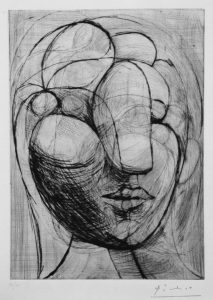
The surrealists never understood what I intended when I invented this word [sur-realism] …, which is what I am after, …a resemblance deeper and more real than the real, that is what constitutes the sur-real. -Picasso (John Richardson, 2007. A Life of Picasso, Vol. 3: 1917-1932, p. 349).
In 1980, seven years after the Grand Master’s death, the Museum of Modern Art celebrated its fiftieth anniversary by presenting a colossal exhibit of his work. The MOMA’s Pablo Picasso: A Retrospective of 1980 was by far the largest and most important Picasso exhibit that had ever been. It was also billed at the time as the largest and most important Picasso exhibit that could ever be. The main reason substantiating this claim is that it featured about 300 of the most important works from Picasso’s estate prior to their installation in the Picasso Museum Paris, which renovations had not yet been completed, in addition to many additional artworks that had not yet been distributed among his heirs. As indicated in the forward to the exhibition catalog, “In the early seventies, when this exhibition was conceived, Picasso himself favored its realization and was prepared to make the required extensive loans from his personal collection.” (R. Oldenburg, p.6) Fortunately, his heirs generously shared his vision. Of course the exhibit drew from the MOMA’s own prodigious collection, and it was also supplemented by a number of significant museum collections from around the world. And it occurred while Guernica still graced the MOMA with its colossal presence, prior to its final move to Spain, as Picasso had willed would occur only after Franco’s death. (I spent the better part of three afternoons in a trance, wandering the many galleries of the MOMA to take in this unworldly experience over and over again. For those of you who were too young or unborn or uninterested or were there but may be in need of a reminder, the exhibition catalog by Bill Rubin, et al., is really a core book for any serious Picasso library.)
Of the handful of prints included in this “capo di tutti capi” exhibit, only four prints were exhibited in multiple states or as a selection of closely related prints. These included the first five states of the Minotauromachy, the two Dream and Lie of Franco etchings, and five wonderful lithographs of Balzac. The fourth was the drypoint at hand. It was not alone, but rather in the company of four related early states and monotypes: state IV and monotypes derived from states V, VI, and VII (Ba 555, 556, and 557). Only the triple-chinned Balzac had brought as many of his likenesses to the party. There were also a number of artworks to be seen related to this Tête de Femme: bronzes, paintings, and drawings, most of which Picasso had created a year or two earlier.
One perhaps would have thought that the prints would have been preparatory to the monumental bronzes and paintings. On the contrary, as a testament to his love of printmaking, they were the end of the line, the last of Picasso’s many variations on the theme, the face of his muse transformed into a mass of interwoven sausages. Either that, or having laboriously created one plaster after another, he turned to the shortcut of printmaking with its ease of iteration–or revision–in order to more rapidly pour the myriad ideas teeming in his head onto paper. He could much more readily create variations on the them by using successive copper plates, or by altering a single plate. But there was a simpler explanation. In fact, Picasso had returned to Paris four months earlier from his hideaway in Boisgeloup, a villa in which he had ensconced his muse–and which doubled as his sculpture studio. Without the space for his grand plasters, he focused his attentions now on the more intimate pursuit of printmaking.
Yet Picasso was famous for his indefatigability, as well as the speed with which he created art. On this winter’s day, while still in the throes of the same creative impulse that had driven him for the last two years, he created all 20 states of this Tête de femme (as well as both states of another etching). While torturing the copper through twenty (!) states, regrettably he pulled but one impression of all but this, the final state. (All the unique impressions are in the collection of the Musée Picasso Paris.) One can only wish he had stopped long enough to run a full edition of at least some of these early states, as several were magnificent and would have easily held their own (see “What’s not There” for a discussion of the earlier states and illustrations of some of them).
But Picasso was not yet done with the sausage-face theme, not until he had incised four additional portraits, and moreover the numerous etchings of the Vollard Suite and beyond which included further variations on this theme. But just as the plasters and bronzes were the culmination of what was, after all, a sculptural style, among the printed works, this Tête de Femme is its uncontested pinnacle. (Though I am extremely fond of B256….)
A word about pentimenti. The richness of this work derives in part from the ghosts of the earlier states in its final form. The term pentimenti is usually used in regard to painting, referring to a visible trace of an earlier painting beneath a layer or layers of paint on canvas. But it applies equally to Picasso’s penchant for leaving traces of where’s he’s been for all to see. A wonderful example is the miraculous portrait of Olga that we unfortunately sold (check out her left hand) In printmaking, sometimes Picasso scraped away at his plate or stone, most famously the series of eleven states of Le Taureau (The Bull, B389, see below), and sometimes he preserved his first thoughts and built upon them. In this Tête de Femme, he did both. In the process, his portrait began as a profile facing (her) right, then she turned partially to the left, and ended up staring straight at us, head-on.
There are only two other artworks besides the drypoint at hand that I know of in which the pentimenti themselves became the style. Both are drawings from the year before, in which the pentimenti are the chief stylistic element, in addition of course to the underlying “surrealist” style of the contour drawings. Here’s one of them, a charcoal on canvas:
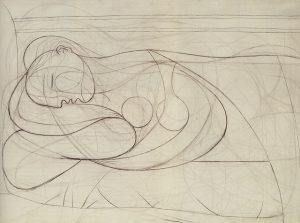
But this drypoint is the only example among all of Picasso’s 2500 or so original prints, or at least the only extreme case, of this incredibly imaginative process. This masterpiece is the pinnacle of the raft of 45 different prints that came to be known as La Caisse à Remords (Box of Regrets). Here’s a good explanation of this mystery box:
Picasso’s output in all media was famously prodigious. It seemed to many observers that what drove Picasso was the desire, almost the need, to create. The end result, the object itself, was of less importance, certainly of less interest, once it had been completed. As a result his various ateliers became storehouses of completed and uncompleted projects. Occasionally Picasso could be persuaded to review these, but it was something he resisted doing because, like many artists, his focus was on the present and future, rather than the past. In 1960, however, whilst moving from Cannes to Notre-Dame-de-Vie near Mougins, a cache of printing plates, some decades old, was unearthed. When the paper wrappers were unfolded they revealed a treasure-trove of images, including tender portraits of Olga, his first wife, of Marie-Thérèse, and of Françoise Gilot. Also discovered were surrealist compositions and early appearances of the Minotaur, which became one of the most important motif’s in Picasso’s career. Intrigued, Picasso asked Jacques Frélaut, a printer at Lacourière’s studio in Paris, to print a trial run to see how they had survived. From a total of 101 plates it was decided that the best 45 would, at last, be printed in an edition of 50 in 1961. Frélaut, a friend of the artist, knew that in order to prevent the project failing again it was imperative that only small batches of prints should be sent to Picasso for signing –anything larger ran the risk of being put off until Picasso could ‘find the time’, which he never would. Unfortunately, Daniel Henry Kahnweiler, legendary dealer and owner of Gallery Louise Leiris, ignored this advice and had the entire edition delivered in one ominous-looking crate. As Frélaut predicted the box was put to one side and eventually buried under waves of newer work. And there it stayed until it was unearthed almost twenty years later, by which time it had been christened ‘box of regrets’, regrets not just of Picasso, but also of Kahnweiler, who thought an opportunity had been lost forever. However, as events transpired, all was not lost. In 1980, the artist’s heirs authorized Galerie Louise Leiris to issue them. Under their supervision, a stamped signature and edition number was applied to each impression. For the most part, the gallery sold the plates individually with the result that very few sets of this fascinating series remain intact. (cf. Christie’s. #3, 7974, 06/21/11).
Despite the fact that Tête de femme was published in an unsigned edition in 1942, no doubt Kahnweiler felt that such a masterpiece would warrant a second edition, which he therefore included as the highlight of his publication in 1961 of the Caisse à Remords editions.
The long list of literature references to the following Tête de Femme (Fig. 20., Bloch 256) evinces the enthusiasm of art historians for this Picasso:
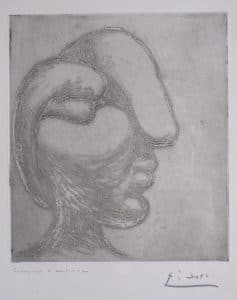
For a discussion of this amazing Tête de Femme (B256, Fig. 20), see it in our catalogue.
Table 10. 1933. Marie-Thérèse portrayed in surrealist, voluminous sculptural styles
| Bloch # | 250 | 251 | 252 | 253 | 254 | 255 | 256 | 257 | 258 |
| Beauty | ***** | * | ** | * | * | *** | ***** | ** | ** |
| Significance | ***** | ** | ** | ** | ** | *** | ***** | * | ** |
| Rarity | ** | *** | *** | *** | *** | *** | *** | *** | *** |
| Size | ** | ** | * | * | ** | ** | * | ** | ** |
| Visibility at a distance | **** | * | * | * | **** | ||||
| Color | |||||||||
| Fading | |||||||||
| Cost | *** | * | * | * | * | * | ** | * | ** |
| Desirability to cost ratio | ** | * | ** | *** | |||||
| Signature | N/ES | ES | ES | ES | ES | N | Y | N | Y |
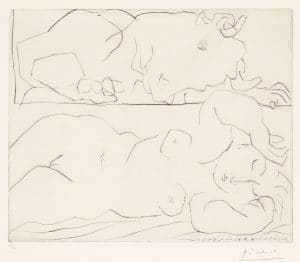
une Dormeuse (Bloch 261)
For a discussion of Minotaure Contemplant une Dormeuse (Fig. 21, Bloch 261), one of my very favorite depictions of the Minotaur and his woman, please see its webpage in our catalogue.
Picasso created four intaglio prints on June 18, 1933, all of which dealt with the theme of the Minotaur. Apart from the first one, Minotaure, Buveur et Femmes (Bloch 200, Fig. 17), the remaining three which followed that day tell a story. According to Brigitte Baer, who, unlike Picasso, numbered the order of their creation, the three prints were created in the order corresponding to the progression of the story. (This is not the only time during this period of the artist’s work in which she made such annotations, but it is the only series of prints of which I’m aware which, taken together with the benefit of her dating and numbering, tell a consecutive story.) As usual, Baer’s titles are more descriptive and informative than those of Georges Bloch. The first “frame” of this story is this drypoint, which she named Minotaure Contemplant Amoureusement une Dormeuse, in which the Minotaur Amorously Contemplates a Sleeping Woman through on open window. The Minotaur has entered the bedroom by the next frame, which Baer titles Minotaure Caressant du Mufle la Main d’Une Dormeuse, (Minotaur Nuzzles the Hand of the Sleeping Woman, Bloch 201, Baer 369) and thereby explains the action which, at least to this viewer, is not completely clear in the print itself, and which Bloch’s simpler title didn’t elucidate. The final frame, Minotaure et Femme Faisant l’Amour (Bloch 262, Baer 372) shows the couple making love. (Bloch, as he often does, titles the scene as a rape, but Baer’s lighter touch is probably also more accurate.)
Apart from the fourth and final print, which was not very well realized, the other three prints Picasso created that day are all masterpieces. In my opinion, the print at hand, Bloch 261, is lovelier than Bloch 201 and is also ten times as rare, yet it sells for a tenth to a fifth of the latter’s price. Such are the vagaries of the marketplace, in this case partly explained by the imprimatur of The Vollard Suite which the latter bears, as well as by the market’s craze for Picasso’s autograph. Go know….
Table 11. Other mostly neoclassical gems, 1933-1934
| Bloch # | 259 | 260 | 261 | 263 | 264 | 265 | 269 | 275 | 276 | 278 |
| Beauty | * | * | ***** | ** | ** | * | * | ** | ** | *** |
| Significance | *** | *** | * | * | ** | *** | ||||
| Rarity | *** | *** | **** | *** | **** | **** | *** | ** | *** | |
| Size | *** | ** | *** | ** | ** | ** | ** | ** | ** | |
| Visibility at a distance | * | ** | ** | * | * | ** | * | |||
| Color | ||||||||||
| Fading | ||||||||||
| Cost | * | * | * | * | * | * | * | * | ** | * |
| Desirability to cost ratio | * | ***** | * | * | * | *** | ||||
| Signature | N | N | ES | N | Y | N | N | N | N/ES | N |

For a discussion of this Femme Torero (Fig. 22, Bloch 280), please see its webpage in our catalogue.
Table 12A. 1934-36
| Bloch # | 279 | 280 | 286 | 288 | 289 | 290 | 291 | 292 | 293 | 294 |
| Beauty | ** | ***** | *** | ***** | * | * | * | *** | * | *** |
| Significance | * | *** | ** | ***** | * | * | * | *** | ||
| Rarity | ** | *** | * | *** | ***** | *** | ** | ** | *** | *** |
| Size | ** | ** | ** | ***** | **** | *** | *** | *** | * | * |
| Visibility at a distance | ** | **** | * | * | * | * | * | |||
| Color | ||||||||||
| Fading | ||||||||||
| Cost | * | * | ** | ***** | *** | ? | * | * | ? | ? |
| Desirability to cost ratio | ***** | * | ||||||||
| Signature | ES | ES | N/ES | Y/N | P | N | ES | ES | N | N |
Table 12B. 1934-36 and 1939, Late Bloch numbers
| Bloch # | 1328 | 1329 | 1330 | 1333 | 1335 | 1336 | 1337 | 1338 | 1339 | 1340 |
| Beauty | *** | ***** | *** | ***** | **** | *** | * | * | ***** | * |
| Significance | *** | *** | *** | ***** | **** | **** | *** | *** | ***** | *** |
| Rarity | *** | *** | *** | ***** | *** | ** | ** | ** | ** | ** |
| Size | ** | ***** | ***** | ***** | ** | ** | ** | ** | ** | ** |
| Visibility at a distance | * | *** | ***** | *** | ***** | **** | ***** | ***** | ||
| Color | ***** | ** | ***** | ** | ** | ** | ||||
| Fading | *** | ** | *** | ** | * | ** | ||||
| Cost | * | ** | ** | ***** | **** | ** | *** | ** | ? | *** |
| Desirability to cost ratio | * | ** | * | |||||||
| Signature | ES | N | N | Y | N | N | N | N | N | N |
Table 12C. More late Bloch numbers, 1939
| Bloch # | 2019 | 2020 | 2021 |
| Beauty | * | * | **** |
| Significance | *** | ||
| Rarity | *** | *** | *** |
| Size | * | * | ** |
| Visibility at a distance | ** | ** | **** |
| Color | ***** | ||
| Fading | **** | ||
| Cost | * | * | *** |
| Desirability to cost ratio | * | ||
| Signature | N | N | N |
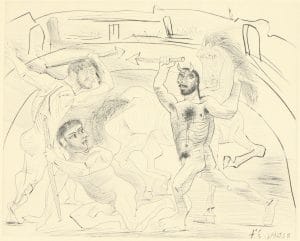
Although Picasso created the world he inhabited, and which he bequeathed to us, he was still to some degree the product of his times. The bullfight, that quintessentially Spanish pastime, served as the springboard for his imagination and, coupled with his passion for Greco-Roman antiquity, may have given rise to this print, a fanciful amalgam of mythology and combat in an arena. The bullfight was the idiom of his culture and the poetry of his youth. It amused and enthralled him throughout his life and served as a metaphor for much of his commentary on the human condition.
On the surface, Combat in the Arena (Fig. 23) depicts gladiators in an ancient Roman arena, a fitting nod to antiquity and perhaps to the precedents of the modern bullfight. The horned combatant, a faun, leads his horse by its mane in pursuit of a fallen gladiator; the faun in turn is pursued by a second gladiator. At a somewhat deeper level, we can’t help being struck by the circularity of motion, perhaps suggesting the circularity of conflict, the senselessness of each person attacking the next in a circle. The choreography of conflict, the dance of death, first depicted in his Femme Torero etchings of a few years earlier (see Bloch 280 above), some of which were included in The Vollard Suite, is echoed here, and a quarter of a century later in his bullfight lithographs and linoleum cuts. In this battle scene we find a smile on the face of the horse and even on that of one of the combatants.
Picasso finished Guernica in June of 1937. Combat in the Arena was created several months later on October 10, just 16 days before the great Weeping Woman in the Tate Modern. Nonetheless, this lighthearted view of conflict clearly lacks the rage of Guernica. Picasso seemingly is as moved to laughter at the senselessness of conflict as angered by the anguish it wreaks. With certain notable exceptions such as Guernica, which he painted but a few months earlier the same year as he created this print, Picasso generally chose to refer only obliquely to the violence of his times. As he explained to an American war correspondent who sought him out at this studio in Paris just days after its liberation, “I have not painted the war because I am not the kind of painter who goes out like a photographer for something to depict. But I have no doubt that the war is in these paintings I have done.” (S.A. Nash, Picasso and the War Years, 1937-1945, Fine Arts Museums of San Francisco, 1998, p. 13). Nash comments as follows: “Aside from his great Guernica of 1937 and The Charnel House of 1945-1946, Picasso’s work from the war-torn years of 1937 to 1945 essentially ignores specific world events. Yet no other artist of the twentieth century left so sustained a moving visual record of the corrosive effect of war on the human spirit and its toll on human life. His achievement was to create a modern alternative to history painting. Through his treatment … he captured a portrait of an era that rises above the strictly personal to comment memorably on life in the shadow of war and the spiritual negativism that resulted, when traditional religion was futile and the ancient furies, all too alive for Picasso, wreaked havoc on humanity. The more narrowly autobiographical or hermetic focus of much of Picasso’s art at this point expands into a give-and-take with history and an interaction with momentous world events.” (ibid., pp. 13-14).
Picasso created but sixteen prints in 1937 (only a few of which are shown in Bloch), but they comprise some of the most artistically significant and the most politically inclined in his career. Other notable examples include Sueno y Mentira de Franco and La Femme qui Pleure, I, (Bloch 1333, one of his two most expensive prints), as well as the other magnificent prints of the Femme qui Pleure series.
Stylistically, Combat in the Arena represents a further departure from the more realistic neoclassical rendering of at least the majority of The Vollard Suite images, at least insofar as its male portraiture is concerned. The women underwent various forms of delightful facial disfigurement and even one total corporeal dissolution and reassembly out of spare household parts (see Bloch 187 above). In Combat in the Arena, all three combatants are depicted with both eyes to one side of the face and both nostrils to one side of the nose in a style typical of many of Picasso paintings but not of any of his prior prints.
To me, Combat in the Arena and the Minotauromachie, both large prints, much larger than any of the Vollards, represent the pinnacle of the Vollard Suite, though they’re not included within it, along with proper Suite pieces such as Minotaure Aveugle Guidée pars une Fillette dans la Nuit (you may have one or two other favorites, such as Minotaure Caressant une Dormeuseand Faun Dévoilant une Femme–I also favor Minotaure, Buveur et Femmes, but that’s just me). Not all share this opinion. For example, if you’ve come this far in this text, my guess is that you’re sporting a Y chromosome. Le Combat is a hard sell. The prices it commands are not at all commensurate with its beauty or its significance. When we last had it, my wife wouldn’t even let me hang it, except in my home office (which, by the by, was just fine with me). Yet one dealer I know won’t part with his impression of this print unless someone were to pry his cold, dead fingers off of it, and I feel just about the same. Why am I posting this print then, you ask? For the opportunity to rant, I suppose, and perhaps also because, as I assemble lists of clients’ desiderata, I would have justification to snap up a second impression of an unpopular print if it crosses my path at a reasonable price…. One year after acquiring our first impression, I happily purchased a second impression of this glorious but difficult print. My wife of course was less pleased. I, however, am comfortably certain with the knowledge that it is truly one of Picasso’s masterpieces–in any medium. I know two other art dealer who have actually sold impressions of this print before (though one doesn’t count, since he sold it to yours truly), but that leaves at least one known historical precedent unrelated to my personal Picasso obsession!
It is noteworthy that Combat is printed on a double sheet of the same paper that was used for The Vollard Suite–these sheets of paper were divided in half for The Suite. Not so for Combat, which therefore sports the Vollard watermark on one side of the sheet and the Picasso watermark on the other.
I could wax eloquent—well, wax, anyway—about Picasso’s shockingly beautiful depictions of these men and beast (their sensitive eyes, their sensual lips, for example), but to what avail? Those of you–precious few, I’ve gathered–to whom the beauty is immediately apparent, wouldn’t need convincing. The rest of you, I have learned, are well beyond my admittedly limited powers of persuasion. And that goes equally for my friends, my wife, and my two-year-old, all of whom I regularly poll, as well as our clients. So I guess I can safely spare you all. In any event, that’s what makes those proverbial, if not Roman, horse races, isn’t it?
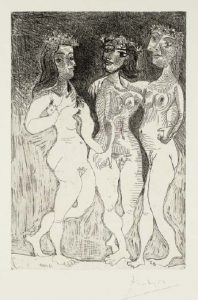
Ask anybody which is their favorite decade of Picasso’s work and the answer you’re likely to receive is the ‘thirties. (That is, unless you’re interrogating a Picasso hater, who, like my Mom, would undoubtedly say the Blue Period.) Yet, unless you’d like to plunk down several tens of millions, it’s hard to come by an affordable work of art from this period featuring some combination of those bulging, tubular eyeballs and those wing-nut ears, with the eyes and nostrils on the same side of the face, which characterized one of the more amazing styles of that decade. There are also precious few prints in this archetypal ‘thirties style, no more than a dozen by my count. Bloch 301 (see above), Bloch 317, and this print are wonderful examples. Following on the heels of several other nice prints on the theme of three women (or the Three Graces) which Picasso visited sporadically starting in the early ‘twenties, this print is the epitome of the lot. Its predecessors are charming in their neoclassical style or in the transitional style of Bloch 176, an amalgam of the neoclassical and the sculptural 1931-32 styles, but this 1938 print wins the contest hands down.
Table13. 1936 -1938
| Bloch # | 295 | 295A | 296 | 297 | 298 | 299 | 300 | 301 | 302 | 303 |
| Beauty | * | *** | **** | * | * | ** | ***** | * | ***** | |
| Significance | * | **** | *** | **** | **** | * | **** | *** | **** | |
| Rarity | *** | ***** | **** | *** | *** | *** | *** | ** | ||
| Size | * | ** | * | *** | *** | *** | **** | **** | *** | ** |
| Visibility at a distance | * | * | * | ** | * | *** | ** | |||
| Color | ||||||||||
| Fading | ||||||||||
| Cost | ? | **** | *** | * | * | ? | * | *** | * | ** |
| Desirability to cost ratio | * | ***** | * | ***** | ||||||
| Signature | N | Y | N | ES | ES | N | ES | Y | ES | Y/N |
et Danseuse (Bloch 306)
Let’s give a name to the artistic style of this wonderful etching, Deux Figures (Fig. 26, Bloch 309): how about Geometric? Since the time of Les Demoiselles d’Avignon, in which Picasso carved space as if with a knife, with a result more akin to a misshapen geode than any habitable room we’ve ever entered, numerous novel iterations of this signature style formed the substrate of many of his best works. Though the term Cubist is often applied to these styles, I rather think it is misapplied. In my opinion, the term Cubism is best left to the work that followed hot on the heels of Les Demoiselles and ended with Synthetic Cubism in the ‘teens. The fragmentation of design in that oeuvre is quite different than the many new styles that followed it, though it certainly could be said that the later styles borrowed from it and built upon it.
In the summer and fall of 1938, Picasso explored this form of stylizing space in a number of fine drawings as well as in this single print. The figures included in these works were stylized in the same manner as the background, thereby forcing the viewer to work a little in order to distinguish the figures from their surroundings. In this print, the space is thrust to the fore, and becomes as important to the design as the figures within it.
In a number of his subsequent prints, which tend to be among my favorites, Picasso used variations of the Geometric style for modeling the face and body of his figures, but only rarely for depicting space. Among the wonderful figural representations are one of his Balzac lithographs, the three lithographs of Paloma, and even a ceramic plate, Tête de Chevre au Profil (Bloch 722 and 726-8; Ramie 151—see below).
Table 14. 1938 – 1939
| Bloch # | 304 | 305 | 306 | 307 | 308 | 309 | 310 | 316 | 317 | 318 |
| Beauty | ** | * | ***** | **** | ***** | **** | ***** | * | **** | * |
| Significance | * | * | **** | *** | **** | **** | ***** | **** | ||
| Rarity | *** | *** | *** | **** | ***** | *** | **** | *** | ** | *** |
| Size | *** | ** | *** | * | * | ** | ***** | ** | * | ** |
| Visibility at a distance | * | * | * | *** | ***** | ** | ||||
| Color | ||||||||||
| Fading | ||||||||||
| Cost | * | * | * | *** | *** | ** | ***** | * | ** | * |
| Desirability to cost ratio | * | ***** | ** | ** | ||||||
| Signature | N | N | N | Y | N | ES | Y | N | Y | ES |
Table 15. 1939-1945
| Bloch # | 320 | 321 | 322 | 323 | 324 | 325 | 359 | 362 | 366 | 370 | 374 |
| Beauty | * | *** | ** | * | * | **** | ***** | ***** | * | * | * |
| Significance | * | * | ** | * | **** | **** | **** | * | |||
| Rarity | *** | *** | *** | *** | *** | *** | *** | * | * | ** | |
| Size | ** | *** | ** | ** | ** | ** | *** | * | *** | * | * |
| Visibility at a distance | * | * | * | ** | ** | ***** | *** | * | |||
| Color | |||||||||||
| Fading | |||||||||||
| Cost | * | ? | ? | * | * | * | ** | * | * | * | * |
| Desirability to cost ratio | **** | *** | ***** | ||||||||
| Signature | ES | N | N | ES | ES | P | N | P | N | N | N |
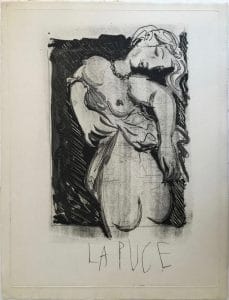
Vollard, Picasso’s first art dealer, asked him to reprise the 18th Century 44-volume Natural History by Georges Louis Leclerc, the Count of Buffon, for which he submitted 31 aquatints, all nice works, some more than others. Picasso’s animal depictions were all rather naturalistic, and none were particularly Picasso-esque. As an afterthought, or perhaps he had planned this subversion all along, he then added a a thirty-second work entitled La Puce (The Flea, Fig. 26a), depicting Marie-Therese picking a star-shaped bug off her derriere. The publication was completed after Vollard’s untimely death by Martin Fabiani, who rejected this print from the regular edition of the book, but included it in the deluxe edition. The edition of this beautiful print is therefore quite rare. According to Baer/Geiser and Goeppert/Cramer, La Puce was included in only the first 35 or 36 of the 226 copies of the book.
Portraits of Picasso’s wives and mistresses typically trade at a particularly large premium, and, of all of his consorts, none of his paintings trade as high as those of Marie-Therese. Unfortunately there are few accomplished printed portraits of her among which to choose. The relative rarity of beautiful portraits of Marie-Therese among Picasso’s prints should further add to the value of La Puce, yet this work remains hugely undervalued in the market.
La Puce has been called “la planche refusée” (“the refused plate”), ostensibly because the publisher noted that Buffon, in all his 44 volumes, did not include the lowly flea. I think the real reason was that the publisher’s sense of humor was about as evolved as that of the insect he had nixed!
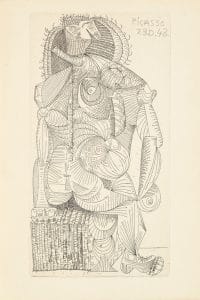
(Contrée; Bloch 362)
For a discussion of this Femme Assise (Fig. 27), please see its webpage in our catalogue.
Previous Chapter | Table of Contents | Next Chapter
